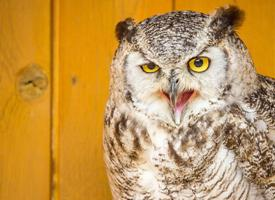
Weights and measures
| Height at the shoulder | from 46 to 68 cm |
|---|---|
| Weight | 1400 g |
| Wingspan | from 101 to 153 cm |
State of endangerment
| Endangered |
Animal description
The Great Horned Owl (Bubo virginianus), often revered as a symbol of wisdom and strength, is a majestic bird of prey that dwells in a diverse array of habitats across the Americas, from the Arctic tundra of Canada to the tropical rainforests of South America. This species is notable for its adaptability, thriving in environments that include dense forests, grasslands, deserts, and even urban areas. It is among the most widely distributed and versatile owls in the Americas, showcasing an incredible ability to coexist alongside human development.One of the most striking features of the Great Horned Owl is its imposing size and appearance. It is a large owl, with females typically larger than males, a common sexual dimorphism among birds of prey. The adult can measure 18 to 25 inches in length, with a wingspan ranging from 40 to 57 inches. This owl possesses a robust body, broad wings, and a deep, resonant hooting call that can be heard over several miles during the still of the night.
The "great horned" moniker derives from the tufts of feathers that resemble horns or ears on top of its head, which are neither horns nor ears but simply feather tufts. These tufts are thought to play a role in camouflage and visual communication among owls. Its face is framed by a distinctive facial disc that helps to funnel sound to its ears, providing exceptional hearing that is crucial for nocturnal hunting. The eyes of the Great Horned Owl are large and yellow, capable of seeing in low light conditions, although they rely more on their acute hearing to locate prey in complete darkness.
The plumage of the Great Horned Owl is a marvel of natural camouflage, featuring mottled brown, gray, and black patterns that allow it to blend seamlessly into its surroundings, whether perched on a tree branch during the day or gliding silently through the night sky. This effective camouflage is vital for both ambushing prey and avoiding detection by potential predators.
As a top predator, the Great Horned Owl has a diverse diet that includes a wide range of animals. It preys on mammals such as rabbits, mice, and skunks, as well as birds, including other raptors. It has even been known to take down prey much larger than itself, showcasing its strength and versatility as a hunter. This owl uses its powerful talons to grasp and kill its prey, often swallowing smaller prey whole.
Breeding season for Great Horned Owls begins in late winter, and unlike many birds, they do not build their own nests. Instead, they often take over nests built by other large birds, or they may nest in tree cavities, cliff ledges, or even on the ground. The female typically lays two to three eggs, which she incubates for about a month while being provisioned by the male. The owlets are born helpless but grow rapidly, fledging from the nest after about six weeks but often remaining with their parents for several more months as they learn the skills needed to survive on their own.
Despite facing threats from habitat destruction, vehicle collisions, and secondary poisoning from rodenticides, the Great Horned Owl has shown remarkable resilience. It remains widespread and relatively common throughout its range, a testament to its adaptability and prowess as a nocturnal predator. Its haunting call continues to echo through the night, a reminder of the wild's enduring mystery and majesty.
Map of occurrence

Similar Animals
New photos of animals
Top 10 animals
- Dolphin gull (Leucophaeus scoresbii)
- Diana monkey (Cercopithecus diana)
- Moustached guenon (Cercopithecus cephus)
- Galápagos tortoise (Geochelone nigra complex)
- Stone loach (Barbatula barbatula)
- Japanese macaque (Macaca fuscata)
- Russian tortoise (Testudo horsfieldii)
- Greek tortoise (Testudo graeca)
- Common flying dragon (Draco volans)
- Vendace (Coregonus albula)


